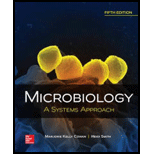
Concept explainers
Ail example of a nonspecific chemical barrier to infection is/are
- a. unbroken skin.
- b. lysozyme in saliva.
- c. cilia in respiratory tract.
- d. all of these.
Introduction:
The body producesvarious chemical barriers which protect the body from bacteria and other harmful microbes and pathogens. For example, tears contain lysozyme which helps in the degradation of the bacterial cell wall.
Answer to Problem 1MCQ
Correct answer:
An example of a non-specific chemical barrier to infections is lysozyme in saliva. Therefore, option (b) is correct.
Option (b) is given as “lysozyme in saliva”.
Explanation of Solution
Justify reasons for the correct statement:
The non-specific chemical barrier of the body includes secretion of lubricating glands. This barrier protects the body from infections. Lysozyme is present in the saliva, which is responsible for cell wall degradation in bacteria by breaking down the peptidoglycan layer.
Hence, option (b) is correct.
Justify reasons for the incorrect statements:
Option (a) is given as “unbroken skin”.
Unbroken skin is not an example of a non-specific chemical barrier. Hence, it is a wrong answer.
Option (c) is given as “cilia in respiratory tract”.
Cilia in the respiratory tract are not an example of a non-specific chemical barrier. Hence, it is a wrong answer.
Option (d) is given as “all of these”.
Lysozyme in saliva is the non-specific chemical barrier to infection which is produced by the body. Hence, it is a wrong answer.
Hence, options (a),(c), and(d) are incorrect.
Lysozyme that presentsin the saliva is an example of a non-specific chemical barrier to infection which is produced by the body.
Want to see more full solutions like this?
Chapter 14 Solutions
Microbiology: A Systems Approach
- Which components are considered a barrier to pathogen entry? all that apply Select one or more: a. PRRs b. plasma cells c. mucus d. lymph nodes e. lysozymearrow_forwardActivated complement proteins ________. a. puncture cells c. attract macrophages b. promote inflammation d. all of the abovearrow_forwardThe vascular changes of inflammationa. lead to an increase in bacterial cells at the injury site.b. decrease the number of leukocytes at the injury site.c. allow plasma proteins to move easily from the bloodstream to theinjury site.d. increase the number of antibodies at the injury site.e. activate lymphocytes.arrow_forward
- Antibodies, complement proteins, and phagocytic cells provide effective protection against all of the following types of infections except: a) Fungi b) Virus-infected cell c) Worms d) Bacteria e) Virusesarrow_forwardThe cytolytic action of the complement system is most similar to the action ofa. interleukin-1.b. platelet-derived growth factor.c. granzymes.d. perforin.e. IgEarrow_forwardExplain Which Enhanced phagocytosis of a cell by the binding of a specific protein is called ________. a. endocytosis b. opsonization c. anaphylaxis d. complement activationarrow_forward
- Shigella, Mycobacterium, and numerous other pathogens have developedmechanisms that prevent them from being killed by phagocytes.a. Suggest two or three factors that help them avoid destruction bythe powerful antiseptics in macrophages.b. Suggest the potential implications that these infected macrophagescan have on the development of disease.arrow_forwardAll of the following are associated with the skin except _____. a. blood vessels b. a low surface density of putative pathogens c. specialized lymphoid tissues d. lymphatics e. an impenetrable physical barrier to microorganisms.arrow_forward_____________-is an example of an inflammatory mediator that stimulateschemotaxis.a. Endotoxin b. Serotonin c. A fibrin clot d. Interleukin-2arrow_forward
- An infected epithelial cell may present theantigen on itsa. MHC class I molecules.b. MHC class II molecules.c. Membrane bound antibodies. d. None of the above. Antibiotics are effective in treatinga. viral infections.b. bacterial infections.c. both viral and bacterial infections.d. neither viral nor bacterial infections.arrow_forwardPart of the complement system of defense is opsonization. This process A.) creates an acidic environment that prevents pathogen attachment B.) causes holes to form in the pathogen's cell walls. C.) coats the pathogen exterior so that it is recognized by the host's phagocytes. D.) causes the pathogen to become trapped in mucus.arrow_forwardAn allergy can best be defined as ______. A) a component of the humoral response B) an exaggerated response to an allergen C) part of the normal immune response D) a type of cell-mediated adaptive immunityarrow_forward


